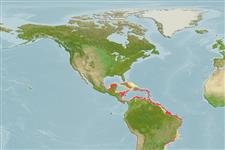>
Clupeiformes (Herrings) >
Engraulidae (Anchovies) > Engraulinae
Etymology: Cetengraulis: Greek, ketos = a marine monster, whale + Greek, eggraulis, -eos = anchovy (Ref. 45335).
More on author: Cuvier.
Environment: milieu / climate zone / depth range / distribution range
ນິເວດວິທະຍາ
ສັດທະເລ; ນ້ຳກ່ອຍ; ລະດັບຄວາມເລິກ 10 - ? m. Tropical; 23°N - 28°S, 98°W - 32°W (Ref. 189)
Western Atlantic: in the Antilles, from Cuba southward; Costa Rica south and east to Colombia and Venezuela, Trinidad south to Itapema, Santa Catarina, Brazil.
Length at first maturity / ຂະໜາດ / ນ້ຳໜັກ / Age
Maturity: Lm 13.7 range ? - ? cm
Max length : 20.5 cm TL ຕົວຜູ້/ບໍ່ມີເພດ; (Ref. 125970); common length : 15.0 cm TL ຕົວຜູ້/ບໍ່ມີເພດ; (Ref. 5217); ນ້ຳໜັກສູງສຸດທີ່ເຄຍຈັດພີມມາ: 140.58 g (Ref. 125970)
ຄີ (ໜາມ)ແຂງຢູ່ຫຼັງປາ (ທັງໝົດ): 0; ຄີ(ໜາມ) ແຂງຢູ່ຄີກົ້ນປາ
ກຸ່ມປາກະດູກແຂງ
ຄວາມຖີ່ຂອງກຸ່ມຖ່າຍທອດພັນ
ປາທີ່ມີການເຄື່ອນຍ້າຍຈາກທະເລໄປຫານ້ຳຈືດ ແລະນ້ຳຈືດຫາທະເລ
ປາທີ່ມີການເຄື່ອນຍ້າຍຈາກທະເລແລະໄປໄຂ່ຢູ່ນ້ຳຈືດ
ຄີກົ້ນຂອງປາ
ສັດທີ່ມີກະດູກສັນຫັຼງ
ການຖ່າຍທອດທາງກຳມະພັນຈາກພໍ່ແມ່ຫາລູກ 0; ຄີກົ້ນຂອງປາ: 18 - 24. Head large and deep. Snout short and pointed, about 2/3 eye diameter; maxilla moderate, tip blunt, just failing to reach lower jaw articulation; fine and numerous lower gill rakers, increasing in large fishes; no gill rakers on posterior face of third epibranchial. Branchiostegal rays 8, long and slender; branchiostegal membrane broad. Silver stripe disappearing at about 10 cm SL (Ref. 189). Dusky dots on upper surface of head and snout, series of large black dots along base of anal (Ref. 37032).
Occurs inshore and forms quite large schools. Enters brackish waters of lagoons and estuaries and can tolerate salinities of 10.32-31 ppt (Santa Cruz Canal, Pernambuco, Brazil). A filter-feeder presumably on both phytoplankton and zooplankton. Spawns off the Araya Peninsula, Venezuela from October to January, with a distinct peak in mid-November. Eggs are oval, spawned at 0230-0500 hours along shoreline out to about 1.5 km and hatching at about 20-24 hours later.
Whitehead, P.J.P., G.J. Nelson and T. Wongratana, 1988. FAO Species Catalogue. Vol. 7. Clupeoid fishes of the world (Suborder Clupeoidei). An annotated and illustrated catalogue of the herrings, sardines, pilchards, sprats, shads, anchovies and wolf-herrings. FAO Fish. Synop. 125(7/2):305-579. Rome: FAO. (Ref. 189)
IUCN Red List Status (Ref. 130435)
Threat to humans
Harmless
Human uses
ການປະມົງ: ທີ່ເປັນການຄ້າໜ້ອຍ; ເຍື່ອ: usually
ຂໍ້ມູນຕື່ມອີກ
ເອກະສານອ້າງອີງການລ້ຽງສັດນ້ຳຂໍ້ມູນການລ້ຽງສັດນ້ຳສາຍພັນກຳມະພັນElectrophoresesການຖ່າຍທອດທາງກຳມະພັນຈາກພໍ່ແມ່ຫາລູກພະຍາດການປຸງແຕ່ງNutrientsMass conversion
ຜູ້ຮ່ວມມືຮູບStamps, Coins Misc.ສຽງຫອຍມີພິດຊະນິດນຶ່ງທີ່ອາໄສໃນທະເລຄວາມໄວປະເພດການລອຍເນື້ອທີ່ເຫືອກOtolithsສະໝອງວິໄສທັດ
ເຄື່ອງມື
Special reports
Download XML
ແຫຼ່ງອີນເຕີເນັດ
Estimates based on models
Preferred temperature (Ref.
123201): 24.4 - 28, mean 27.4 °C (based on 76 cells).
Phylogenetic diversity index (Ref.
82804): PD
50 = 0.7500 [Uniqueness, from 0.5 = low to 2.0 = high].
Bayesian length-weight: a=0.00490 (0.00392 - 0.00612), b=3.23 (3.17 - 3.29), in cm total length, based on LWR estimates for this species (Ref.
93245).
ຊັ້ນເຂດຮ້ອນ (Ref.
69278): 2.1 ±0.07 se; based on food items.
ຄວາມຢືດຢຸ່ນ (Ref.
120179): ຂະໜາດກາງ, ປະຊາກອນຕຳ່ສຸດທີ່ໃຊ້ເວລາສອງເທົ່າ 1.4 - 4.4 ປີ (K=0.13-0.22; Fec=8,189 (batch fecundity)).
Prior r = 0.55, 95% CL = 0.37 - 0.83, Based on 3 stock assessments.
Fishing Vulnerability (Ref.
59153): Moderate vulnerability (44 of 100).
Climate Vulnerability (Ref.
125649): Moderate to high vulnerability (50 of 100).
Nutrients (Ref.
124155): Calcium = 189 [109, 487] mg/100g; Iron = 1.52 [0.77, 2.95] mg/100g; Protein = 18.3 [16.7, 19.9] %; Omega3 = 0.389 [0.196, 0.833] g/100g; Selenium = 31.4 [14.3, 73.9] μg/100g; VitaminA = 24.9 [5.4, 82.9] μg/100g; Zinc = 2.65 [1.77, 4.20] mg/100g (wet weight);
